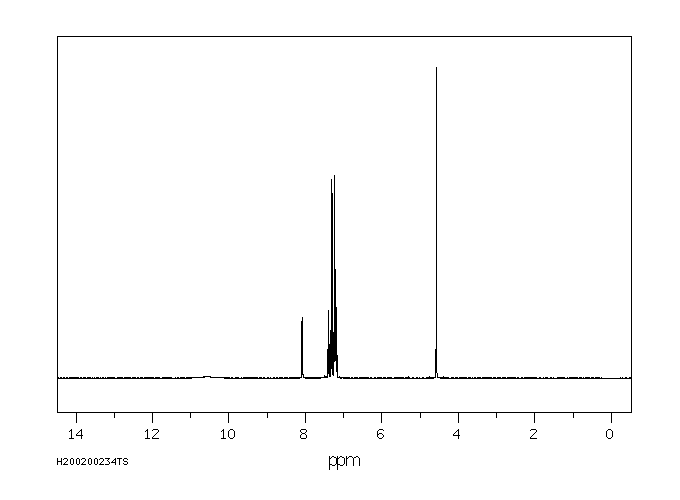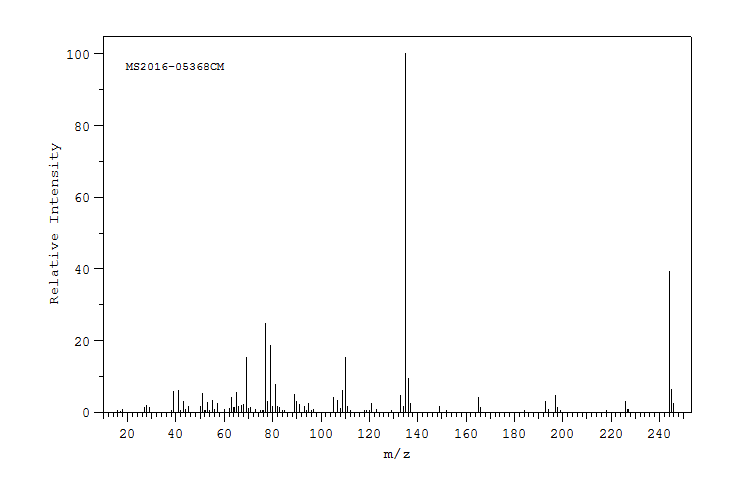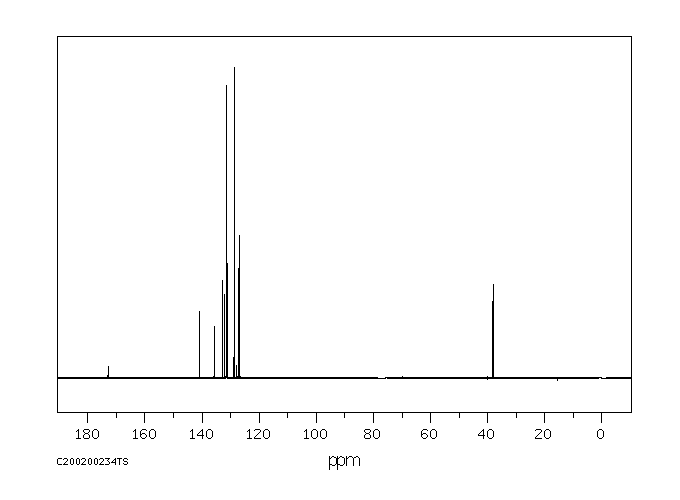2-苯基巯甲基苯甲酸 | 1699-03-2
-
物化性质
-
计算性质
-
ADMET
-
安全信息
-
SDS
-
制备方法与用途
-
上下游信息
-
文献信息
-
表征谱图
-
同类化合物
-
相关功能分类
-
相关结构分类
物化性质
-
熔点:109-113 °C
-
沸点:357.23°C (rough estimate)
-
密度:1.2347 (rough estimate)
-
溶解度:乙腈(微溶)、氯仿(微溶)、DMSO(微溶)、甲醇(微溶)
-
稳定性/保质期:
在常温常压下保持稳定,应避免与酸及酸性氯化物接触,以防发生氧化反应。
计算性质
-
辛醇/水分配系数(LogP):3.5
-
重原子数:17
-
可旋转键数:4
-
环数:2.0
-
sp3杂化的碳原子比例:0.071
-
拓扑面积:62.6
-
氢给体数:1
-
氢受体数:3
安全信息
-
危险品标志:Xi
-
安全说明:S26,S37/39
-
危险类别码:R36/37/38
-
海关编码:2930909090
-
储存条件:请将容器密封保存,并存放在阴凉、干燥处。
SDS
模块 1. 化学品
产品名称: 2-Phenylthiomethylbenzoic Acid
修改号码: 5
模块 2. 危险性概述
GHS分类
物理性危害 未分类
健康危害 未分类
环境危害 未分类
GHS标签元素
图标或危害标志 无
信号词 无信号词
危险描述 无
防范说明 无
模块 3. 成分/组成信息
单一物质/混和物 单一物质
化学名(中文名): 2-苯基硫甲基苯甲酸
百分比: ....
CAS编码: 1699-03-2
俗名: 2-Phenylmercaptomethylbenzoic Acid
分子式: C14H12O2S
模块 4. 急救措施
吸入: 将受害者移到新鲜空气处,保持呼吸通畅,休息。若感不适请求医/就诊。
皮肤接触: 立即去除/脱掉所有被污染的衣物。用水清洗皮肤/淋浴。
若皮肤刺激或发生皮疹:求医/就诊。
眼睛接触: 用水小心清洗几分钟。如果方便,易操作,摘除隐形眼镜。继续清洗。
如果眼睛刺激:求医/就诊。
食入: 若感不适,求医/就诊。漱口。
紧急救助者的防护: 救援者需要穿戴个人防护用品,比如橡胶手套和气密性护目镜。
模块 5. 消防措施
合适的灭火剂: 干粉,泡沫,雾状水,二氧化碳
特殊危险性: 小心,燃烧或高温下可能分解产生毒烟。
2-苯基硫甲基苯甲酸 修改号码:5
模块 5. 消防措施
特定方法: 从上风处灭火,根据周围环境选择合适的灭火方法。
非相关人员应该撤离至安全地方。
周围一旦着火:如果安全,移去可移动容器。
消防员的特殊防护用具: 灭火时,一定要穿戴个人防护用品。
模块 6. 泄漏应急处理
个人防护措施,防护用具, 使用个人防护用品。远离溢出物/泄露处并处在上风处。
紧急措施: 泄露区应该用安全带等圈起来,控制非相关人员进入。
环保措施: 防止进入下水道。
控制和清洗的方法和材料: 清扫收集粉尘,封入密闭容器。注意切勿分散。附着物或收集物应该立即根据合适的
法律法规处置。
模块 7. 操作处置与储存
处理
技术措施: 在通风良好处进行处理。穿戴合适的防护用具。防止粉尘扩散。处理后彻底清洗双手
和脸。
注意事项: 如果粉尘或浮质产生,使用局部排气。
操作处置注意事项: 避免接触皮肤、眼睛和衣物。
贮存
储存条件: 保持容器密闭。存放于凉爽、阴暗处。
远离不相容的材料比如氧化剂存放。
包装材料: 依据法律。
模块 8. 接触控制和个体防护
工程控制: 尽可能安装封闭体系或局部排风系统,操作人员切勿直接接触。同时安装淋浴器和洗
眼器。
个人防护用品
呼吸系统防护: 防尘面具。依据当地和政府法规。
手部防护: 防护手套。
眼睛防护: 安全防护镜。如果情况需要,佩戴面具。
皮肤和身体防护: 防护服。如果情况需要,穿戴防护靴。
模块 9. 理化特性
固体
外形(20°C):
外观: 晶体-粉末
颜色: 极淡的黄色-浅黄色
气味: 无资料
pH: 无数据资料
熔点:
111°C
沸点/沸程 无资料
闪点: 无资料
爆炸特性
爆炸下限: 无资料
爆炸上限: 无资料
密度: 无资料
溶解度:
[水] 无资料
[其他溶剂] 无资料
2-苯基硫甲基苯甲酸 修改号码:5
模块 10. 稳定性和反应性
化学稳定性: 一般情况下稳定。
危险反应的可能性: 未报道特殊反应性。
须避免接触的物质 氧化剂
危险的分解产物: 一氧化碳, 二氧化碳, 硫氧化物
模块 11. 毒理学信息
急性毒性: 无资料
对皮肤腐蚀或刺激: 无资料
对眼睛严重损害或刺激: 无资料
生殖细胞变异原性: 无资料
致癌性:
IARC = 无资料
NTP = 无资料
生殖毒性: 无资料
模块 12. 生态学信息
生态毒性:
鱼类: 无资料
甲壳类: 无资料
藻类: 无资料
残留性 / 降解性: 无资料
潜在生物累积 (BCF): 无资料
土壤中移动性
log水分配系数: 无资料
土壤吸收系数 (Koc): 无资料
亨利定律 无资料
constaNT(PaM3/mol):
模块 13. 废弃处置
如果可能,回收处理。请咨询当地管理部门。建议在可燃溶剂中溶解混合,在装有后燃和洗涤装置的化学焚烧炉中
焚烧。废弃处置时请遵守国家、地区和当地的所有法规。
模块 14. 运输信息
联合国分类: 与联合国分类标准不一致
UN编号: 未列明
模块 15. 法规信息
《危险化学品安全管理条例》(2002年1月26日国务院发布,2011年2月16日修订): 针对危险化学品的安全使用、
生产、储存、运输、装卸等方面均作了相应的规定。
2-苯基硫甲基苯甲酸 修改号码:5
模块16 - 其他信息
N/A
上下游信息
-
上游原料
中文名称 英文名称 CAS号 化学式 分子量 —— 2-Phenylmercaptomethyl-benzoesaeureaethylester 1531-79-9 C16H16O2S 272.368 —— 2-methylthiophenylbenzonitrile 92164-25-5 C14H11NS 225.314 -
下游产品
中文名称 英文名称 CAS号 化学式 分子量 —— 2- -benzylalkohol 15150-01-3 C14H14OS 230.331 —— 2-[(phenylsulfanyl)methyl]benzaldehyde 1432518-89-2 C14H12OS 228.315 —— (2-Dimethylaminoethyl)-2-phenylthiomethyl-benzoat 14187-98-5 C18H21NO2S 315.436 —— (3-Dimethylaminopropyl)-2-phenylthiomethyl-benzoat 14187-96-3 C19H23NO2S 329.463 2-(苯基磺酰基甲基)苯甲酸 2-[(benzenesulfonyl)methyl]benzoic acid 300396-14-9 C14H12O4S 276.313 —— 2-Phenylmercaptomethyl-benzoesaeurechlorid 1699-04-3 C14H11ClOS 262.76 —— S-Phenyl-2-(phenylthiomethyl)-thiobenzoat 15149-99-2 C20H16OS2 336.478
反应信息
-
作为反应物:参考文献:名称:Stereoselective synthesis of (E)-11-(2-chloroethylidene)-6,11-dihydrodibenzo(b, e)thiepin.摘要:合成了三种酸性代谢产物(5-7),它们是6, 11-二氢-11-(3-二甲氨丙烯基)二苯并[b, e]噻吩(dothiepin)的衍生物。在合成过程中,6, 11-二氢-11-乙烯基二苯并[b, e]噻吩-11-醇(2)与SOCl2的反应立体选择性地生成了(E)-11-(2-氯乙烯基)-6, 11-二氢二苯并[b, e]噻吩(3)。讨论了该反应的机制。DOI:10.1248/cpb.38.1066
-
作为产物:描述:参考文献:名称:Dihydrodibenzothiepine:流行性感冒帽依赖性核酸内切酶抑制剂中有望的疏水药效基团。摘要:这项工作描述了一组与氨基甲酰吡啶酮自行车(CAB)支架结合的流感帽依赖性核酸内切酶(CEN)抑制剂的发现研究。使用流感CEN抑制活性,抗病毒活性和药代动力学(PK)参数作为指标,在CAB支架的N-1和N-3位置进行了结构活性关系(SAR)研究,这是结合两种金属的独特模板。N-1位的疏水取代基对于CEN抑制活性和抗病毒活性极为重要,而二氢二苯并噻吩平是最有前途的药效团。化合物(S)-13i在体内显示出比磷酸奥司他韦有效的病毒效价降低鼠标模型。本文所述的CAB化合物用作具有三环支架的baloxavir marboxil的前导化合物,该化合物已于2018年在日本和美国获批。DOI:10.1016/j.bmcl.2020.127547
文献信息
-
Synthesis and Biological Activity of 11-(4-(Cinnamyl)-1-piperazinyl)-6,11-dihydrodibenz(b,e)oxepin Derivatives, Potential Agents for the Treatment of Cerebrovascular Disorders.作者:Mikio KUROKAWA、Fuminori SATO、Yoshinobu MASUDA、Takayuki YOSHIDA、Yuko OCHI、Kayoko ZUSHI、Iwao FUJIWARA、Shunsuke NARUTO、Hitoshi UNO、Jun-ichi MATSUMOTODOI:10.1248/cpb.39.2564日期:——A series of 11-[4-(cinnamyl)-1-piperazinyl]-6, 11-dihydrodibenz[b, e]oxepins and related compounds were synthesized and evaluated for their protective activities against complete ischemia, normobaric hypoxia, lipidperoxidation and convulsion. Structure-activity relationship studies of this series led to the finding of (E)-1-(3-fluoro-6, 11-dihydrodibenz[b, e]oxepin-11-yl)-4-(3-phenyl-2-propenyl)piperazine dimaleate (50), AJ-3941 with the most appropriate property for combined pharmacological activities.
-
Über neuartige tricyclische Thiazepin- und Thiepin-Derivate Untersuchungen über synthetische Arzneimittel, 8. Mitteilung作者:F. Gadient、E. Jucker、A. Lindenmann、M. TaeschlerDOI:10.1002/hlca.19620450616日期:——Es werden Synthesen und die pharmakologischen Eigenschaften von neuartigen tricyclischen Verbindungen, und zwar von Derivaten des 5,11-Dihydro-benzo[b]-pyrido [2,3-e]thiazepins[1,4] und des 6,11-Dihydro-dibenzo[b, e]thiepins, beschrieben.Es werden Synthesen和Pharmacologischen Eigenschaften von Neuartigen Tricyclischen Verbindungen,以及Zwar von Derivaten des 5,11-Dihydro-benzo [b] -pyrido [2,3-e] thiazepins [1,4]和des 6,11-Dihydro-二苯并[b,e]噻吩类化合物,贝司列本。
-
착색 조성물, 컬러 필터 및 그 제조 방법, 화상 표시 장치, 고체 촬상 소자, 그리고, 신규 화합물申请人:FUJIFILM CORPORATION 후지필름 가부시키가이샤(520060414739)公开号:KR20150058282A公开(公告)日:2015-05-28하기 일반식(1)으로 표시되는 화합물 및 그 호변(互變) 이성체로 이루어지는 군에서 선택되는 적어도 1종의 화합물을 함유하는 착색 조성물. 일반식(I) 중, R∼R은, 각각 독립적으로, 수소 원자, 또는 1가의 치환기를 나타낸다. R는, 수소 원자, 할로겐 원자, 알킬기, 아릴기, 또는 헤테로환기를 나타낸다. R 및 R은, 각각 독립적으로, 수소 원자, 할로겐 원자, 알킬기, 또는 알콕시기를 나타낸다. Ma는 금속 또는 금속 화합물을 나타낸다. X는 Ma와 결합 가능한 기를 나타낸다. n1 및 n2는, 각각 독립적으로, 1∼8의 정수를 나타낸다.
-
Asymmetric synthesis of carbocycles: use of intramolecular conjugate displacement作者:Dinesh T. Sreedharan、Derrick L. J. CliveDOI:10.1039/c3ob40115d日期:——Intramolecular conjugate displacement (ICD), the process illustrated in eqn (1), has been applied to the Morita–Baylis–Hillman adducts formed from (5S)-5-(L-menthyloxy)-2(5H)-furanone and aldehydes that are substituted in the γ- or δ-position by geminal phenylthio groups. When the initial Morita–Baylis–Hillman alcohols are acetylated and oxidized to geminal sulfones, deprotonation causes ring closure
-
Synthesis and Anticancer Evaluation of New 1,3,4-Oxadiazole Derivatives作者:Camelia Elena Stecoza、George Mihai Nitulescu、Constantin Draghici、Miron Teodor Caproiu、Octavian Tudorel Olaru、Marinela Bostan、Mirela MihailaDOI:10.3390/ph14050438日期:——
In order to develop novel chemotherapeutic agents with potent anticancer activities, a series of new 2,5-diaryl/heteroaryl-1,3,4-oxadiazoles were designed and synthesized. The structures of the new compounds were established using elemental analyses, IR and NMR spectral data. The compounds were evaluated for their anticancer potential on two standardized human cell lines, HT-29 (colon adenocarcinoma) and MDA-MB-231 (breast adenocarcinoma). Cytotoxicity was measured by MTS assay, while cell cycle arrest and apoptosis assays were conducted using a flow cytometer, the results showing that the cell line MDA-MB-231 is more sensitive to the compounds’ action. The results of the predictive studies using the PASS application and the structural similarity analysis indicated STAT3 and miR-21 as the most probable pharmacological targets for the new compounds. The promising effect of compound 3e, 2-[2-(phenylsulfanylmethyl)phenyl]-5-(4-pyridyl)-1,3,4-oxadiazole, especially on the MDA-MB-231 cell line motivates future studies to improve the anticancer profile and to reduce the toxicological risks. It is worth noting that 3e produced a low toxic effect in the D. magna 24 h assay and the predictive studies on rat acute toxicity suggest a low degree of toxic risks.
为了开发具有强大抗癌活性的新型化疗药物,设计并合成了一系列新的2,5-二芳基/杂芳基-1,3,4-噁二唑化合物。通过元素分析、红外光谱和核磁共振光谱数据,确认了新化合物的结构。对这些化合物在两种标准化的人类细胞系HT-29(结肠腺癌)和MDA-MB-231(乳腺腺癌)上的抗癌潜力进行了评估。通过MTS测定细胞毒性,利用流式细胞仪进行细胞周期阻滞和凋亡实验,结果表明MDA-MB-231细胞系对这些化合物的作用更为敏感。利用PASS应用程序和结构相似性分析进行的预测研究结果显示,STAT3和miR-21是新化合物最可能的药理靶点。化合物3e,2-[2-(苯基硫基甲基)苯基]-5-(4-吡啶基)-1,3,4-噁二唑,特别对MDA-MB-231细胞系的显著效果,激发了未来改善抗癌特性和减少毒理风险的研究动力。值得注意的是,3e在D. magna 24小时实验中产生了低毒效应,并且对大鼠急性毒性的预测研究表明毒性风险程度较低。
表征谱图
-
氢谱1HNMR
-
质谱MS
-
碳谱13CNMR
-
红外IR
-
拉曼Raman
-
峰位数据
-
峰位匹配
-
表征信息









